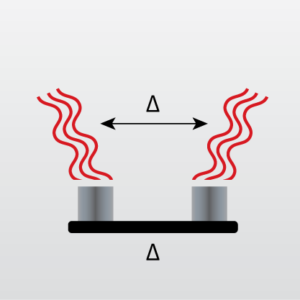Thermogravimetry Differential Thermal Analysis (TG/DTA)
Home » Our Techniques » Physical/Chemical Characterization » TG-DTA
Thermogravimetry Differential Thermal Analysis or TG/DTA is a simultaneous thermal analyzer that can characterize multiple thermal properties of a sample in a single experiment. The TG component measures temperatures where decomposition, reduction or oxidation occurs. It simultaneously measures the weight changes associated with decomposition, oxidation and any other physical or chemical changes that result in sample weight loss or gain. The DTA component shows whether decomposition processes are endothermic or exothermic. The DTA also measures temperatures corresponding to phase changes where no mass loss occurs, such as melting, crystallization and glass transitions.
Fundamentally, the “TG” of TG/DTA is very similar to standard thermogravimetric analysis (TGA). A TG/DTA measures the change in sample weight as a function of temperature (and/or time) under controlled gas atmosphere and temperature. Graphing the percent weight change over a programmed temperature range enables the study of physical or chemical processes that have caused the sample to lose or gain weight.

The “DTA” refers to differential thermal analysis. The DTA technique measures the difference between the sample temperature (Ts) and the temperature of a reference (Tr). A plot of Ts – TR over a programmed temperature range will show a series of peaks or step changes that map the temperatures where thermal events occur. However, the amount of heat absorbed or released by the sample as it undergoes changes in temperature cannot be accurately quantified by the TG/DTA instrument. This heat quantity, known as change in enthalpy (delta H), can be accurately measured using differential scanning calorimetry (DSC).
Ideal Uses of TG/DTA
- Thermal stability studies
- Monitoring mass changes of materials under controlled gas atmosphere and temperature: volatiles, reactive gas evaluation, filler content, compositional analysis, material identification
- Phase transitions of metals and alloys
- Qualitative analysis of phase transitions: melting, Tg, crystallization
- Determining the effect of oxidative or reductive atmospheres on materials
- Analysis of polymers, organic and inorganic materials
Strengths
- Rapid screening of thermal properties of materials
- Simultaneous acquisition of thermogravimetry and phase transition data
- Small sample size
- Choice of atmospheres (inert or reactive)
- Used for high temperature analysis of phase transitions
Limitations
- Does not measure heat capacity
- Not quantitative for enthalpy change (e.g. heat of fusion) measurement
TG/DTA Technical Specifications
- Temperature: ambient to 1100°C
- Atmosphere:
- Inert – Argon, Nitrogen
- Oxidative – O2, Air
- Reductive – Hydrogen/Argon mixture
- Sample: 0.1 – 180 mg
- Heating Rate: 0.01 to 100.00°C/minute
Would you like to learn more about using TG/DTA?
Contact us today for your Thermogravimetry/Differential Thermal Analysis needs. Please complete the form below to have an EAG expert contact you.